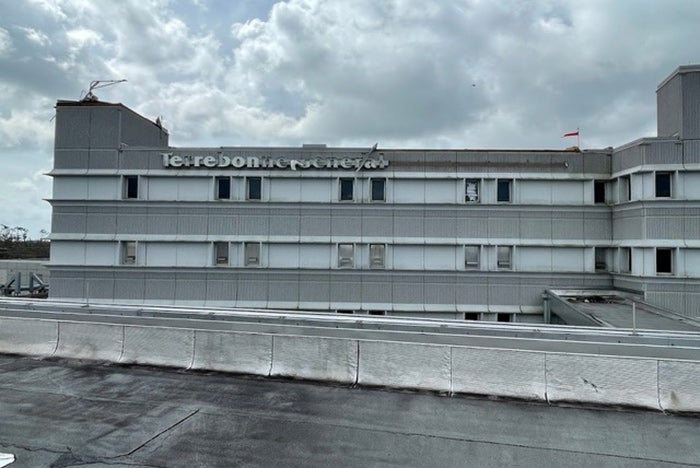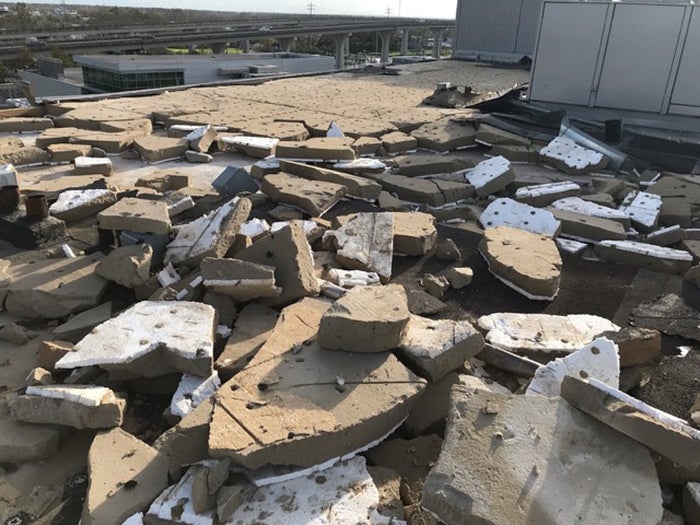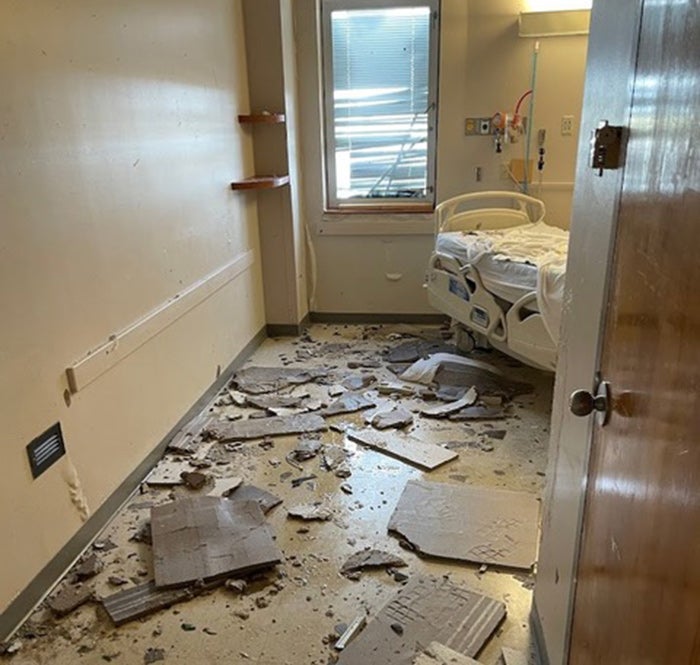Louisiana hospital shares lessons learned after Hurricane Ida
Editor’s note: This article is the fourth in a series on the impact of Hurricane Ida on health care facilities, the experiences of health care facilities managers in affected areas, and hurricane preparedness and response.

Hurricane Ida's high winds of 150 miles per hour caused extensive damage in Louisiana, including at Terrebonne General's facility.
Image courtesy of Terrebonne General Health System
The evacuation of a health care facility is a monumental task under any circumstances. Patients are a very vulnerable population, and their health care needs are often critical and time sensitive. Resources needed for an evacuation, such as vehicles to transport patients, are usually scarce. The evacuation process requires finding bed space, ensuring patients will receive the same level of care, and coordinating with other organizations and agencies. In short, evacuations are complicated and involve extensive planning and preparation.
Terrebonne General Health System in Louisiana faced the challenges of an evacuation earlier this year. Although the facility is in a region that has seen many hurricanes, the impacts of Hurricane Ida in late August were unprecedented. The slow-moving storm hovered for more than 10 hours over Houma, the largest city in Terrebonne Parish, about 60 miles southwest of New Orleans. The high winds, reaching 170 miles per hour, and torrential rains caused serious roof, water and electrical damage to buildings throughout the area.
“We’ve never experienced winds of that magnitude, from either Hurricane Andrew, Katrina or any other storm,” says Troy Ledet, director of facilities at Terrebonne General Health System. “Our main roofing system failed as a result of the high winds peeling back the flashing, causing the roofing membrane and lightweight concrete to delaminate and become airborne.”

The building suffered lightweight concrete failure and lightweight roofing separation as a result of Hurricane Ida
Image courtesy of Terrebonne General Health System
The north side of the five-story patient tower, a large portion of the 1 million-square-foot campus, suffered catastrophic damage, including broken windows that resulted in debris from the roof and rain water in patient rooms. But the destruction did not end there.
“We had internal flooding from the failed roofing system that penetrated our roof deck,” Ledet says. “We lost all utilities, and we had to go on to emergency power. We lost our city-provided natural gas supply, which meant our steam boilers couldn’t operate and we couldn’t maintain adequate temperature and humidity within the building.”
After the hurricane, maintaining water service to the facility was a top priority. Terrebonne General coordinated with local suppliers and contractors, the Governor’s Office of Homeland Security and Emergency Preparedness and the Federal Emergency Management Agency. Ledet says the 16-hour process involved bringing in tanker trucks to get enough pressure to successfully keep the potable water and cooling tower makeup water systems operational.
Still, the severe damage created conditions that posed safety risks to patients and staff, and evacuation of the facility started a day later. In another collaborative effort, Terrebonne General and its partners — Ochsner Health, Acadian Ambulance, the U.S. Coast Guard, the Louisiana Hospital Alliance, AirMed, and the Terrebonne Parish Office of Homeland Security and Emergency Preparedness — worked to transfer 120 patients to other facilities across the state, including 50 COVID-19 patients.
Ledet says the facilities team plays an important part in an evacuation, but the relocation of patients, staff and services includes many participants and moving parts.
“Our role in facilities is to maintain the building so that the evacuation can happen,” he says. “The nursing personnel work to find locations to transfer patients, but it’s a team approach and everyone gets involved in the evacuation process.”
Ledet also credits Phyllis Peoples, Terrebonne General’s president and CEO, and the entire leadership team for the recovery and response to Hurricane Ida.
“We had an all-hands-on-deck approach throughout the entire event and our recovery response efforts,” he says. “For over 10 days, leadership never left the building. Our concern was bringing back patient care as quickly and safely as possible because we know how much the community needs our facility.”

It took a multidisciplinary effort to safely transfer patients to neighboring facilities
Image courtesy of Terrebonne General Health System
Hurricane Ida was not the first time Ledet had dealt with the evacuation of a health care facility — only, previously, his facility was on the receiving end. Hurricane Katrina in 2005 also brought high winds to Terrebonne Parish, but the impacts there were not as severe as in other areas of the region. At the time, Ledet worked at a different facility in the same community that ended up taking in patients from hospitals in the New Orleans area.
Ledet’s first-hand knowledge about hurricane response and recovery and management of a facility during evacuation procedures highlights the value of facilities managers sharing information, resources and lessons learned.
“Networking with your peers is critical for the success of facilities directors,” he says. “When you are involved in the American Society for Health Care Engineering and you experience an event like the one that we experienced, you are able to pick up the phone, call your peers and offer support to one another.”
While Terrebonne General’s outpatient services were up and running soon after Hurricane Ida, restoring inpatient services took longer because the damage to the patient tower has required more extensive mitigation and demolition. The design of the new tower roof will exceed the stringent Miami-Dade County building code requirements for wind loads of 160 miles per hour. The roofing system will withstand 200-mile-per-hour winds, a higher standard that will be needed as the strength and severity of hurricanes increases.
Planning for future climate events is a continually evolving process, building on past experience while contending with uncertainties.
“Our emergency preparedness plan is always in place because we’re on the coast,” Ledet says. “We work with our local office of emergency preparedness continually throughout the year. We conduct drills for events like this, and we have agreements with different facilities across the state for an evacuation event. But we never thought the hurricane would impact us to this magnitude.”
Learn More
The Health and Human Services Office of the Assistant Secretary for Preparedness and Response (ASPR) Technical Resources, Assistance Center, and Information Exchange (TRACIE) has compiled health care facility evacuation and sheltering resources, including education and training tools, guidelines and protocols, and exercise materials.
A 2018 issue of the ASPR TRACIE newsletter, The Exchange, focused on health care facility evacuations due to wildfires and hurricane-related flooding. When Hospitals Become Islands: One Facility’s Evacuation Story looks at the 2017 evacuation of a Baptist Beaumont Hospital facility in Beaumont, Texas, after Hurricane Harvey and a breach in the city’s water pumps.
The California Emergency Medical Services Authority’s Incident Planning Guide addresses issues associated with evacuation, shelter-in-place and hospital abandonment.




